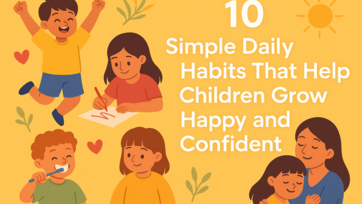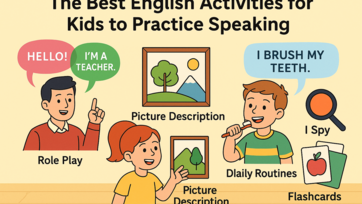Encouraging children to use English doesn’t have to be confined to the living room or study table. The great outdoors offers engaging, practical, and playful ways for kids aged 4–8 to develop their speaking, listening, and vocabulary skills. Here are some teacher-tested outdoor activities that naturally nurture language learning—and make family time more memorable.

1. Nature Walk “I Spy” Game
What it is: A classic “I spy” using English vocabulary during a nature walk.
How it works:
Choose a location—backyard, park, or forest path. One person says: “I spy something green.” The child searches and names objects in English: “leaf,” “grass,” “tree.” Take turns so everyone practices speaking and listening.
Why it works:
Combines movement with vocabulary learning. Seeing and naming objects in context helps cement word–object associations.
2. Outdoor Storytelling with Props
What it is: Tell simple stories using items found outdoors.
How it works:
Gather natural props—leaves, stones, sticks. Create a short story: “Once upon a time, a leaf fell into a river.” Invite the child to continue: “And then the stone jumped in!” End by acting it out together.
Why it works:
Encourages creativity, sequencing, and use of new words. Props make abstract vocabulary concrete and memorable.
3. Scavenger Hunt with English Clues
What it is: A picture-based treasure hunt using English clues.
How it works:
Prepare a list of simple items (e.g., “something yellow,” “a stick longer than your hand”). Children find and point out the items, describing them: “I found a yellow flower!” Use photos or simple sentences to guide them.
Why it works:
Promotes reading, comprehension, and speaking in a fun, movement-rich activity. It’s one of the many recommended outdoor language-learning methods
4. Obstacle Course with Spoken Directions
What it is: A playful obstacle course guided by English instructions.
How it works:
Set up a small course (e.g., cones, sticks). One child is blindfolded—another gives directions in English: “Take two steps forward, jump over the stick, turn left.” Switch roles afterward.
Why it works:
Emphasizes listening skills and clear communication. Children learn verbs and spatial language (left, right, jump) in context cambridgeenglish.org.
5. Outdoor Role-Play
What it is: Romanticize everyday activities by role-playing in a natural setting.
How it works:
Pretend you’re at an outdoor café or grocery stand you’ve created with toy fruits and household items. Practice English phrases accordingly: “May I have an apple?” or “Here’s your ticket.”
Why it works:
Children engage in functional language practice in a relaxed, creative setting—one of the top benefits of outdoor language learning cambridgeenglish.org+2lingopie.com+2Dreamstime+2.
6. Nature Journaling
What it is: Drawing and labeling natural items in a simple outdoor journal.
How it works:
Bring a notepad and pencil outdoors. Have the child draw a flower and label it: “flower,” “petal,” “stem.” They can also create simple sentences like, “I see a yellow flower.”
Why it works:
Blends writing, observation, and vocabulary. Combining art and language supports retention Dreamstime.
7. Birdwatching Bingo
What it is: Play bingo with outdoor vocabulary like “bird,” “cloud,” “leaf.”
How it works:
Prepare bingo cards with images or words. As children spot items in nature, they mark them off. First to complete a line shouts “Bingo!”
Why it works:
Teaches listening, naming, and pattern recognition while getting fresh air.
8. Outdoor Rhymes and Chants
What it is: Recite English rhymes while walking or collecting items.
How it works:
Use familiar chants like “One, two, buckle my shoe” as you walk and touch your shoes or leaves. Alternatively, create a rhyme about nature.
Why it works:
Rhythm builds pronunciation and memory. Linking actions to words reinforces meaning naturally.
9. Outdoor Reading Picnic
What it is: Read a simple English book together outside.
How it works:
Bring a short, illustrated story. Find a shady spot, read aloud, and encourage the child to repeat phrases or point out words.
Why it works:
Different setting renews interest; natural surroundings connect text to environment.
10. Weather Reporting
What it is: Let children observe and report on the day’s weather.
How it works:
Each day, ask: “Is it sunny or cloudy?” “Is it warm or cold?” Create a mini weather forecast with photos from earlier.
Why it works:
Teaches weather-related vocabulary and casual conversation structure.
Why Outdoor Activities Work
-
Outdoor learning boosts motivation, self-regulation, social skills—and language use in real life .
-
Cambridge English supports outdoor-based play to enhance language naturally .
-
Nature-based learning improves focus, curiosity, and meaningful language connections .
Tips for Success
-
Keep it short: 15–20 minute sessions match children’s natural attention spans.
-
Prepare simple visuals: Use flashcards or paper drawings to support clarity.
-
Follow their lead: Notice what excites them—a bug, rock, flower—and build language around it.
-
Repeat and vary: Use the same activity 2–3 times, then change location or theme.
-
Join in: Model phrases, celebrate answers, and respond with enthusiasm—your presence makes the activity meaningful.
Getting Started
Begin with a simple “I spy” or scavenger hunt in your backyard. Use weather-appropriate clothes, a notepad, and 10–15 minutes of calm, focused interaction. Try one activity each day for a week, then reflect: which motivated your child most?
Final Thoughts
Practicing English doesn’t have to be indoor, structured, or stressful. By tapping into children’s love of exploration and play, you create language-learning opportunities that feel like fun—not homework. Outdoor activities build vocabulary, listening, speaking, and confidence—in real-world context.
Try one activity this week—whether a nature-based game, obstacle course, or story picnic—and watch how English becomes part of your child’s everyday discovery.
; ?>







